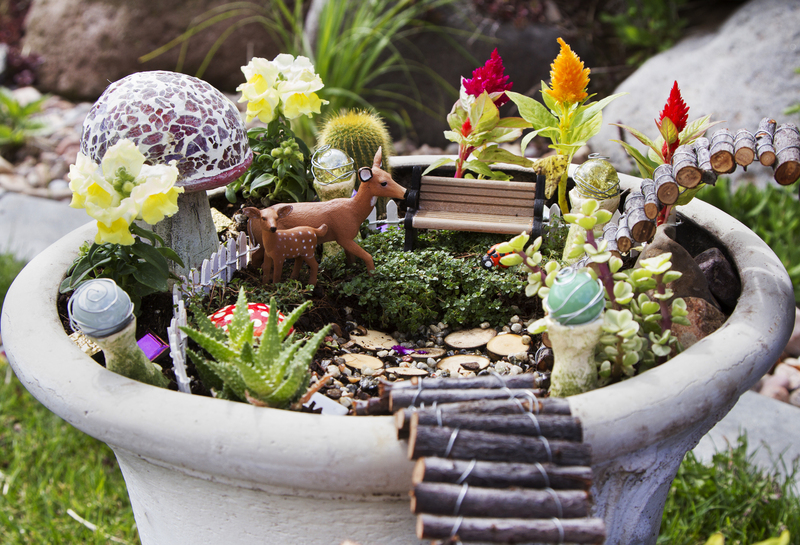Winter Care Tips to Protect Delicate Garden Plants
Posted on 10/06/2025
Winter Care Tips to Protect Delicate Garden Plants
As the days grow shorter and the air chills, gardeners everywhere start to prepare for winter's harsh embrace. Winter care tips for delicate garden plants become essential knowledge to preserve the beauty and bounty that we've nurtured all year. Whether you are tending to tender perennials, cherished annuals, or exotic treasures, learning how to protect delicate garden plants in winter can make the difference between thriving blooms and heartache come spring. In this comprehensive guide, we'll cover everything you need to know to shield your garden's most vulnerable members from snow, frost, and chill.
Understanding the Needs of Delicate Plants in Winter
Before outlining protections, it's vital to identify which plants require special attention. Delicate garden plants typically include:
- Tender perennials (such as fuchsias or dahlias)
- Exotic plants not native to your region
- Young saplings and recently planted shrubs
- Container plants that are more exposed to the elements
Each of these categories comes with its own vulnerabilities, whether it's to frost, excessive moisture, or drying winds. Being aware of their winter sensitivity will inform your strategy for preservation.
Assess Your Garden's Microclimates
No two gardens are alike. Pay attention to microclimates in your yard: sheltered areas beside buildings, sunny south-facing beds, or cold-prone low spots all impact how the winter cold will affect your plants. Choose protective measures tailored for each unique garden environment.

Essential Garden Tools and Supplies for Winter Protection
Proper preparation is half the battle. Compile the following supplies ahead of time:
- Mulch (bark, straw, leaves, or compost)
- Horticultural fleece or frost blankets
- Burlap or breathable garden fabric
- Insulating covers for pots and containers
- Wooden stakes or hoops
- String or garden twine
- Cloche covers or cold frames (for especially delicate specimens)
Having these materials on hand ensures you'll be ready when a surprise frost or storm is forecast.
Timing: When to Start Winter Protection
Don't wait until the first frost hits! Although some plants benefit from gradual cooling, proactively shielding them from extreme temperatures is key. Generally, start preparing when nighttime temperatures consistently fall below 5?C (41?F), or about two weeks before your area's average first frost. Check your local climate calendar or consult a gardening almanac for precise timing.
Strategic Mulching for Winter Plant Protection
Mulching is among the most effective winter garden care tips. A thick layer of organic mulch acts as a blanket, stabilizing soil temperatures and preventing freeze-thaw cycles that can heave roots out of the ground. Here's how to do it right:
- Clear away dead foliage and weeds first to minimize hiding spots for garden pests.
- Layer 5-10 cm (2-4 inches) of mulch around the base of each plant, taking care not to heap it against stems or trunks.
- For extra sensitive plants, create a "mulch dome" by mounding mulch over the crown and root zone.
- Use straw, shredded leaves, or bark chips for best results. Avoid hay, which may harbor weed seeds.
Mulched beds are less prone to significant soil temperature swings and maintain healthier moisture levels throughout the cold months.
Wrapping and Covering: Shielding Plants from Frost and Snow
Some delicate garden plants, especially evergreens and flowering shrubs, benefit from being physically covered when deep freezes or heavy snow threaten. Use these methods:
Horticultural Fleece and Frost Blankets
Lightweight fleeces are ideal for draping over beds of perennials or individual plants on frosty nights. Secure with stakes and string, ensuring the cover doesn't touch leaves directly.
Burlap Wraps
Burlap is a classic solution for protecting shrubs and small trees. After mulching around the base, wrap shrubs loosely with burlap, securing it with twine. For evergreens, wrap the whole plant or construct a burlap screen around the windward side to shield from desiccating winter winds.
Using Cloches and Cold Frames
- A garden cloche (glass or plastic dome) can protect individual prized plants or seedlings in garden beds.
- Cold frames provide a mini greenhouse effect for low-growing, tender plants, trapping heat from sun during the day and keeping frost at bay overnight.
Watering Rituals: Preventing Winter Drought
Many gardeners mistakenly believe watering can stop once the cold arrives. In reality, winter drought stress is a real danger, especially for evergreens and shallow-rooted plants. Follow these winter watering tips:
- Water deeply before the ground freezes. Hydrated plants are better able to withstand winter cold.
- During warm, dry spells, check soil moisture and water as needed (especially for container plants and recent transplants).
- Avoid waterlogging--well-drained soil is essential to prevent root rot in winter.
Remember to drain hoses and garden faucets before a deep freeze arrives.
Special Care for Potted and Container Plants
Plants grown in containers are particularly vulnerable to winter damage because their roots are less insulated from the cold. Follow these steps to keep your pots healthy:
- Move containers to a sheltered spot--preferably near a wall or inside a garage or shed.
- Elevate pots off cold ground using pot feet, bricks, or an old pallet.
- Insulate pots by wrapping them in bubble wrap, burlap, or hessian.
- Group containers together for mutual protection and cover with garden fleece on cold nights.
- Water sparingly during winter but do not let soil dry out completely.
Pruning: When and What to Trim Before Winter
Not all plants benefit from heavy pruning before cold weather. For many delicate garden plants, it's wise to delay major pruning until spring to avoid stimulating tender new growth that's prone to frost damage. However, there are a few helpful trimming tips:
- Cut back diseased, dead, or damaged stems to reduce the risk of fungal infections.
- Remove any spent annuals and tidy beds to reduce pest hiding spots.
- Leave seed heads on some perennials--it adds winter interest and provides food for wildlife.
Managing Snow and Ice Accumulation
Snow can act as an insulator for plants--unless it's wet, heavy, and likely to break branches. Here are the best practices:
- Gently brush off heavy snow from branches using a broom before it causes breakage.
- Avoid using salt or chemical de-icers near plant beds--these can damage roots and soil.
- Protect tree trunks from splitting with trunk wraps or by painting with white latex paint to reflect sunlight.
Caution: Never try to remove ice from branches as you may accidentally snap them--let it melt naturally.
Secret Weapons: Anti-Desiccant Sprays and Windbreaks
Evergreens suffer not only from cold, but from winter wind and sun that can cause them to dry out (a process known as "winter burn"). Try these strategies:
- Apply an anti-desiccant spray to the leaves of broadleaf evergreens in late fall.
- Install a temporary windbreak--such as a burlap or snow fence--on the side exposed to prevailing winter winds.
Both approaches can dramatically improve winter survival rates for your tender shrubs and small trees.

Additional Winter Care Tips for Delicate Garden Plants
For comprehensive winter protection, don't overlook the following clever strategies that can help your precious plants:
- Choose hardy varieties whenever possible. If you know your area experiences harsh winters, select cultivars bred for resilience.
- If possible, plant delicate species in microclimates (e.g., against south-facing walls), where reflected heat and winter shelter offer them an edge.
- Mark the locations of dormant herbaceous perennials to avoid accidentally digging them up when the garden looks bare.
- Stay vigilant for signs of wildlife damage--rabbits and deer will feed on bark and branches when food is scarce. Use physical barriers or repellents as needed.
- Keep a winter garden journal. Document what works and what doesn't, helping you refine your strategy for next year.
Frequently Asked Questions: Protecting Garden Plants in Winter
Q: How do I know if my plants need extra winter protection?
A: Research the cold-hardiness zone for each plant species. Plants grown near or beyond their cold tolerance cutoffs should always be protected using the strategies above.
Q: Can I use plastic to cover my plants?
A: While some use plastic for short-term frost protection, it can trap moisture and cause condensation, leading to rot. Breathable materials (like horticultural fleece or burlap) are safer for overwintering garden plants.
Q: When should I remove winter covers?
A: As soon as the danger of sustained hard frosts has passed and temperatures warm consistently in early spring, gradually remove covers and mulch mounds. Avoid sudden exposure to strong sun and wind by acclimatizing plants over a few days.
Conclusion: A Safe Winter for Your Garden's Most Vulnerable Residents
By following these winter care tips for delicate garden plants, you'll enjoy peace of mind knowing you've done all you can to ensure vibrant growth next spring. Remember: Each garden is unique, so experiment with different methods and adapt your routine based on what your plants need. With preparation, attention, and a little extra care, your delicate garden plants can survive--and even thrive--through winter's most challenging months. Happy gardening!

